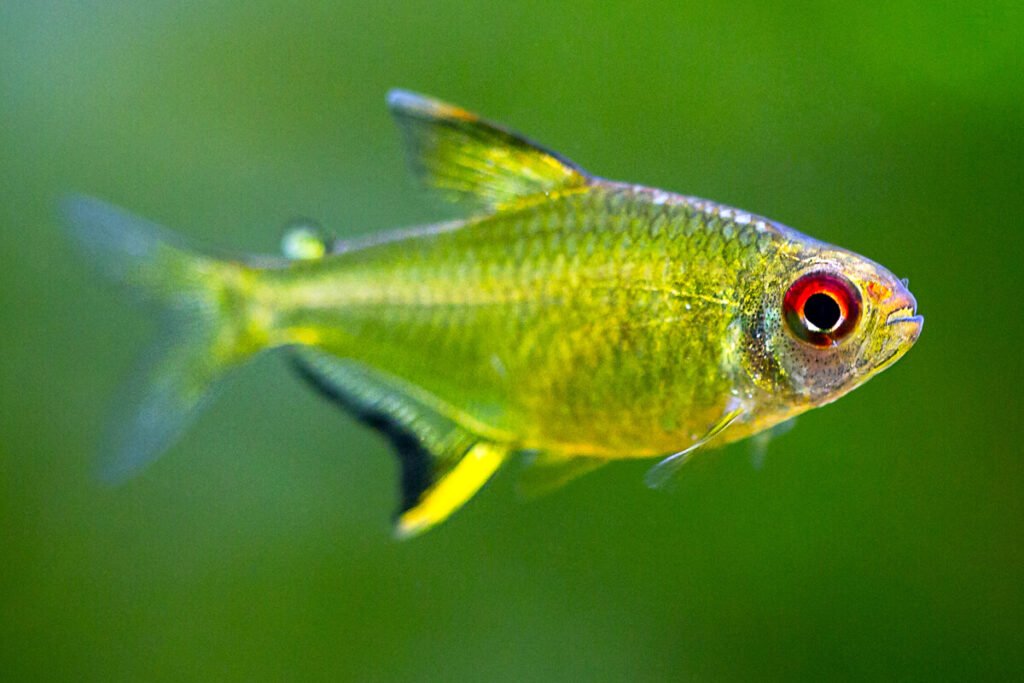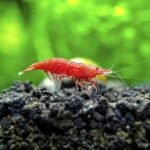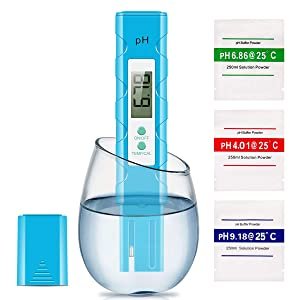Lemon Tetra, scientific name Hyphessobrycon pulchripinnis, is a common freshwater tropical fish. They are omnivorous, feeding on small invertebrates, crustacea, filamentous algae, fallen fruit, and suchlike. They have bright colors, robustness, and a calm temperament. These conditions are easily replicated in captivity, resulting in natural school behavior, breeding, and even defensive techniques. Lemon tetras have become extremely popular in the aquarium business, starting as one of the first species available (introduced in 1932) and commercially produced and now continuing as a basic inhabitant of most aquariums.
Summary of species
Lemon tetras originate in Brazil, and there is a debate about where they are collected, but evidence shows that they are in the basin of the Tapajós and Xingu rivers. A peaceful and hardy fish, the tetra-lemon is an easy-to-care freshwater species. These fish are an excellent addition to a community aquarium and can flourish in large groups. They are excellent choices for both experienced and novice aquarists. Lemon Tetras resides on narrow tributaries of the Tapajós River.
Lemon Tetra care: Tank size, food, school, and breeding
Lemon tetra (Hyphessobrycon pulchripinnis) brings a vibrant, elegant look to your community aquarium. This small but energetic fish is easy to enjoy and easy for someone new to the hobby to keep. Here is the most detailed guide about this fish.
Lemon Tetra Care: Diet, Tank Mates, Size, Behavior
Lemon Tetras are delightful freshwater fish that can add a colorful touch to any aquarium. And of course, they are very active and fun. But for some reason, aquarium hobby often underrepresents this species. Read this information to understand how to care for the lemon tetra. Here you’ll find more detailed information about your tank mates’ behavior, size, diet, and more. We like lemon tetras and have met a few other owners in the fishkeeping community.
Appearance
Lemon tetras have a diamond-shaped body similar to many other tropical fish tetras. However, lemon tends to be taller and more horizontally compressed. The fish can be sexed using the color of the anal fin. The eyes of this tetra have nothing in common with its body, showing an intense red color, which also makes it unique! The lower half of the iris appears bright red that deepens and dulls due to the health of the fish. Other notable physical characteristics include an adipose fin and the lemon yellow color presented in some parts of the body and fins.

Average size
The typical size of the lemon tetra is 1.5 inches when fully grown. These fish are tiny, which makes them comfortable regardless of the space available to them. Despite their smaller size, they have an intense coloration, standing out among the other inhabitants. They are great fish for nano tanks.

Lemon tetra description
The largest male tetra-lemons are 1.5 inches long. The body is translucent to a light yellowish hue, and we see the lateral shimmering line that goes from the gill coverage to the beginning of the tail fin. The front ends are bright yellow, while the tip and edge of the dorsal fin and the posterior ray of the anal fin are black.
Commercial presence
The Lemon Tetra was introduced to the aquarium market around the beginning of the 20th century. These species are not threatened with extinction in the wild. It is easy to breed in captivity means that aquarists can produce a healthy population themselves. They are hardy fish and get along well with many other species; this adds even more attraction to community aquariums. Like some other tetras, they spawn together and produce many eggs.
Wild habitat
Tetra lemons are freshwater fish, but they cannot tolerate a hostile environment. Lemon tetras are not listed in the IUCN as an endangered species with a relatively narrow distribution and no environmental threat. They prefer shallow and slower river environments in their natural habitat, gravitating towards small streams, areas of flooded forest, and small puddles. The waters they live in are typically straightforward and contain a high mineral content compared to other parts of the river’s tributary.
Lemon tetra information
Lemon tetra is endemic to a specific region in Brazil. The lemon tetras have a yellowish color. The color of the species can change concerning the color of the substrate and the aquarium lighting. The ideal water temperature is 68 to 82 F. The Lemon Tetra is a peaceful fish and will work well in a quiet community aquarium. The aquarium can be a planted tank with a pH between 5 and 7.5, and the water hardness should be between 18 and 215 ppm. The fish is straightforward to breed in captivity compared to other tetras.
Lemon Tetra Care
Lemon Tetra can live up to eight years, although the average is about five years. However, these species are incredibly stable and are known to enjoy a good life in captivity. Lemon tetras are hardy animals, able to survive in many different situations. As mentioned here before, the tetra-lemon is strictly a tropical freshwater fish.
Lemon tetra setup
Lemon tetras kept in tanks that are too small can become shy and stressed. The suggested minimum size for the aquarium is 60 centimeters (24 inches). Try to imitate the nature of Lemon Tetra in your aquarium location. To make the fish more colorful, you can use dark aquarium water, as the contrast effect enhances the fish’s color. A densely planted aquarium containing at least a large open area for swimming can help fish. It is possible to find other peaceful fish species of similar size, which require the same water temperature and chemical characteristics as lemon tetras.
Tank size & tank setup
When designing the tank, it’s best to start with somewhere around 20 gallons or more. Keeping at least six fish together in a tank is ideal as it is a schooling species. A lemongrass aquarium should look like its habitat, densely planted, with clear water and moderate flow. This species needs hiding places and low light, include caves and plants, to block light.
Water parameters
Tetra lemons are obtained from shallow streams with soft, clear water. Lemon tetras are hard enough to tolerate most normal water conditions in a tropical aquarium. To ensure that this water parameter remains consistent, you should invest in an accurate water test kit. The ability to get fast, accurate readings is a must for any aquarist and will allow you to make adjustments to the water as needed.
Tank Size
It’s a small species, so that you can keep them in nano tanks. Despite this, lemon tetras are school fish and prefer to live in ponds. A tank containing 20 gallons of water will satisfy a small number of six fish. They are incredibly active fish and need a large area of water to have fun.
Conditions of water
The water temperature for Lemon Tetra Hyphessobrycon pulchripinnis is between 68 and 82 Fahrenheit. The ideal pH range for these freshwater fish is between 5.5 and 7.5, and the hardness range is between 3 to 20 dGH. This aquatic fish will happily swim across the surface of the water and prefers a moderate water flow. Like most fish, they need clean water free of nitrates, nitrites, and ammonia. Maintain a weekly maintenance routine in the tank, cleaning the substrate and changing the water.
What to put in their tank
The tetra lemon blooms in densely planted clear waters in the Amazon region. They adapt very well to Amazon-themed aquariums, even blackwater ones. Start with the substrate; a layer of sand or fine gravel should suffice. Then add driftwood and roots to simulate your biotope. Rocks are also welcome. Mix multiple plants for a natural forest look. Use low-lying plants, taller-stemmed plants, and floating plants. The school should have a large open swimming area— standard filtration equipment, water flow, and lighting correctly.
Recreating a natural environment
Lemon Tetras requires a wide-open space for them to swim. The following elements are some of the main ornamental features to be used when trying to recreate the lemon tetras environment. Optional factors in a tank configuration include dry leaves, tannins, and floating plants. This species performs well in community aquariums with other peaceful inhabitants and will likely share the same food as its tank mates. These fish accept a wide variety of frozen, live and dry, natural and commercial foods.
Food & Diet
Lemon tetras are omnivorous and highly competitive for food. They must rely on high-quality food for their meals. Provide just enough food for them to consume without leftovers. Keep your diet varied, and your fish will have everything they need to stay in top shape and healthy. Feed several small meals throughout the day. Feed a variety of living, frozen snacks to keep the fish fit and healthy. Give the fish a small supply of food, and they will be healthy, and it will help color the fish.

Food and Diet
Their diet should consist of high-quality dry flakes; supplements such as life, fresh or frozen foods are welcome—lemon tetras enjoy daphnia, brine shrimp, and mosquito larvae. Lemon tetras love to eat plants and small animals in the wild, including invertebrates, arachnids, and ants. It is vital to provide the fish with high-quality food.
Breeding
Hyphessobrycon pulchripinnis are easily bred in the home aquarium. These fish disperse eggs and show no parental care. Spawning can be caused by conditioning the breeders with live feed and maintaining the water temperature between 75 and 78.8 Fahrenheit and pH levels between 6.5 and 7.2. A small 3-4 gallon breeding tank is ideal. Under suitable conditions, a large adult can produce as little as 300 eggs in one spawn. Eggs ripen within 24 hours.
Lemon Tetra breeding
A separate tank is specifically needed for breeding and make sure it is full of plants. Tetras spread their eggs and usually try to eat them, hence the importance of plants as they help to protect them. A lemon tetra that lays thousands of eggs a day is not uncommon. In approximately three days, the eggs will hatch, and the chicks will start eating feed in a few days. Lemon tetras are relatively simple creatures, easy to handle and maintain. They add the perfect color to any aquarium. They take varied conditions and can live along with many species of fish.
Lemon Tetra Tank Mates
Lemon tetras are small and delicate enough to become fish food, so don’t keep it with big or aggressive fish. If you decide to keep it in a community tank, choose fish of similar sizes and with the same peaceful temperament. Choose tank mates, such as dwarf shrimp, peaceful-tempered fish, or the like. The lemon tetra can live with a wide variety of tank mates, especially in larger aquariums.
Tank Mates
Lemon tetras generally do well with more laid-back species that don’t become too aggressive when faced with competition for food or territory. Even relatively calm cichlids can be aggressive with tetras; likewise, the little tetra may decide to eat the shrimp. Always remember that the tank owner must continually monitor the tank’s residents and prevent problems.
Behavior & Temperament
Lemon Tetra is a tranquil fish that likes to preserve peace. Like most other tetras, they prefer group life. Males can display aggression during mating, which will lead to a small fight between them, but without significant problems. These are fish that like to group in large schools.
Schooling behavior of Lemon Tetra
Tetra lemon works best when grouped in shoals, and when kept alone, it can be stressed by being anxious. In the wild, lemon tetras unite in large flocks that sometimes contain several thousand fish. Even though they are quiet, males can sometimes show aggression when trying to court females. They can be kept with other small fish species such as other tetras, Apistogramma, or plecos. They are often intimidated by larger fish, but they like to eat small animals like shrimp.
Life span
The average lifespan of the lemon tetra is about five years. In a poorly managed environment, fish experience stress, disease, and premature death. Like all other fish, the life span can be reduced considerably if proper care is not provided. There are many cases where these fish have survived their lifespan, but it is usually a combination of reasonable care and luck.
Diseases
Hyphesobrycon pulchripinnis is a powerful fish in any tank. When kept in polluted aquariums, fish can become stressed, causing fungus and disease to develop. Like most tropical freshwater fish, the tetra is prone to parasitic infestations, skin worms, and bacterial infections. Before introducing new specimens into your main aquarium, quarantine them to make sure they are disease-free. Before adding plants and decorations to your aquarium, you need to sanitize them.
Potential diseases
Many common illnesses need your attention, including bacterial infections and parasitic infections. You can treat most problems through quarantine, providing pure water, a good diet, and prescription drugs. To keep the water parameters ideal and clean, perform maintenance with a weekly water change. Always have a kit to test nitrogen levels, pH, and everything else you need. When suffering from an illness, the bright colors disappear. If you pay attention to red-eye coloration, you can use their appearance to gauge the health quality of tetra lemons.
Lemon Tetras vs. Other Popular Tetras
Tetras generally share the same general characteristics for their maintenance in tanks. Lemon Tetras require specific water parameters to survive but are still relatively tough and worth your investment as new inhabitants in your aquarium.
Conclusion
No matter how much experience you have, lemon tetra care should never be a problem for you. As long as you follow our recommendations and keep an eye out, you and your fish will be happy.







![Top [2023] 10 Best HOB (Hang On Back) Filter For Aquariums, Planted, Reef Tanks Top [2023] 10 Best HOB (Hang On Back) Filter For Aquariums, Planted, Reef Tanks](https://aquariumhunter.com/wp-content/uploads/2021/03/Best-1-1.jpg)